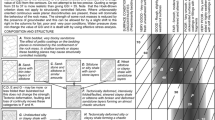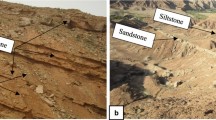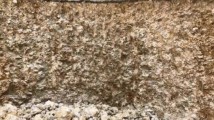Abstract
Over the last years, several researchers have investigated heterogeneous rock mass behaviour using the Geological Strength Index (GSI) classification system in conjunction with the Hoek–Brown criterion. Because of the variable composition of such rock masses, the availability of both petrographic and mechanical features of the intact rock is essential in order to carry out geomechanical studies. Starting from the detailed evaluation of the strength and deformability of the intact rock, the GSI method was applied to the Sanremo flysch formation, which is widely outcropping in Western Italy and involved in many engineering projects. It is characterized by both a remarkable lithological heterogeneity and a structural complexity. Petrographic analysis and laboratory tests allowed the definition of the main constituent lithotypes and the identification of their mechanical properties, whereas geomechanical surveys were performed in order to estimate the GSI values and the strong/weak ratio. Based on the frequency of strong and weak layers, a “weighted average” of intact rock values was used in estimating the rock mass parameters. Three main rock mass classes were identified, and a basic engineering geological map of the study area was prepared.








Similar content being viewed by others
References
Abbo M (1995) La misura della resistenza a compressione monoassiale nel Flysch di Sanremo. Professione Geologo 4:19–28
AGI (1979) Some Italian experiences on the mechanical characterization of structurally complex formations. In: Proceedings of the 4th international congress ISRM, vol 1, pp 827–846
Agliardi F, Crosta GB, Frattini P (2012) Slow rock-slope deformation. In: Clague JJ, D. Stead D (eds) Landslides: types, mechanisms and modelling. Cambridge University Press, pp. 207–221
ASTM (1998) Standard test method for elastic moduli of intact rock core specimens in uniaxial compression. American Society for Testing and Materials, ASTM Designation D3148–96:306–310
Barla G, Gelati R, Sfondrini G (1987) Study on the major rock complexes of the Northern Apennines. Geol Appl e Idrogeol 32:197–241
Berardi R, Bellingeri P (1998) Deformability of rock masses by empirical approaches: influence of rock quality and in situ stress state. It Geo J 1:39–62
Bizjak KF, Petkovšek B (2004) Displacement analysis of tunnel support in soft rock around a shallow highway tunnel at Golovec. Eng Geol 75(1):89–106. doi:10.1016/j.enggeo.2004.05.003
British Standard Institution (1981) Code of practice for site investigations, BS 5930 HMSO, London
Budetta P, Nappi M (2011) Heterogeneous rock mass classification by means of the geological strength index: the San Mauro formation (Cilento, Italy). Bull Eng Geol Env 70:585–593. doi:10.1007/s10064-011-0351-1
Button E, Riedmuller G, Schubert W, Klima K, Medley E (2004) Tunnelling in tectonic melanges-accommodating the impacts of geomechanical complexities and anisotropic rock mass fabrics. Bull Eng Geol Environ 63:109–117. doi:10.1007/s10064-003-0220-7
Carobene L, Cevasco A (2011) A large scale lateral spreading, its genesis and Quaternary evolution in the coastal sector between Cogoleto and Varazze (Liguria—Italy). Geomorphology 129(3):398–411. doi:10.1016/j.geomorph.2011.03.006
Cavallo C, Cevasco A, Ferrari M, Piazza M (2008) Valutazione dell’idoneità di materiali flyschoidi derivanti da scavo in sotterraneo per interventi di ripascimento di spiagge ghiaiose. Studi Costieri 15:25–37
Cevasco A (2008) Relationships between some geotechnical properties of the Genoese area’s clayey rock formations and the instability problems that affected the historic tunnels between Polcevera and Scrivia Valleys (Ligurian Appennines). GEAM 124:47–53
D’Elia B, Esu F, Federico G, Tancredi G (1985) Geotechnical properties and slope stability in structurally complex clay soils. AGI Golden Jubilee Volume, pp 215–224
De Vita P, Cevasco A, Cavallo C (2012) Detailed rock failure susceptibility mapping in steep rocky coasts by means of non-contact geostructural surveys: the case study of the Tigullio Gulf (Eastern Liguria, Northern Italy). Nat Hazards Earth Syst Sci 12:867–880. doi:10.5194/nhess-12-867-2012
Deere DU (1968) Chapter 1: geological considerations. In: Stagg. KG, Zienkiewicz OC, editors. Rock mechanics in engineering practice.: Wiley London,pp. 1–20
Deere DU, Miller RP (1966) Engineering classification and index properties for intact rock. Technical report n. AFWL-TR-65-116, Air Force Weapons Laboratory, New Mexico
Donath FA (1964) Strength variation and deformational behaviour in anisotropic rock. In: Judd WR (ed) State of stress in the Earth’s crust. Elsevier, New York, pp 281–298
Eberhardt E (2012) The Hoek-Brown Failure Criterion. Rock Mech Rock Eng 45:981–988. doi:10.1007/s00603-012-0276-4
Esu F (1977) Behaviour of slopes in structurally complex formations. In: Proceedings of the international symposium on the geotechnics of structurally complex formations, pp 292–304
Franklin J, Hoek E (1970) Developments in triaxial testing technique. Rock Mech vol II:223–228
Giammarino S, Fanucci F, Anfossi R, Arbarelli C, Cobianchi M, Cuppari A, Dabove GM, De Stefanis A, De Stefanis P, Di Stefano A, Finocchiaro F, Fravega P, Morelli D, Orezzi S, Piazza M, Rossi E, Rosti D, Vannucci G (2010a) Carta Geologica d’Italia alla scala 1:50.000-Foglio “San Remo” N.258-271 con Note Illustrative. ISPRA-Regione Liguria. A.T.I.-SystemCart s.r.l.-L.A.C. s.r.l.-S.EL.CA., Firenze
Giammarino S, Fanucci F, Orezzi S, Rosti D, Morelli D, Cobianchi M, De Stefanis A, Di Stefano A, Finocchiaro F, Fravega P, Piazza M, Vannucci G (2010b) Note Illustrative della Carta Geologica d’Italia alla scala 1:50.000-Foglio “San Remo” n.258-271. ISPRA-Regione Liguria. A.T.I.-SystemCart s.r.l.-L.A.C. s.r.l.-S.EL.CA., Firenze
Glawe U, Upreti B (2004) Better understanding of the strengths of serpentinite bimrock and homogeneous serpentinite. Felsbau Rock Soil Eng 22(5):53–60
Hawkins AB (1998) Aspects of rock strength. Bull Eng Geol Env 57:17–30
Hoek E (1983) Strength of jointed rock masses. Golder Associates, Vancouver, Canada, Twenty-third Rankine Lecture presented to the British Geological Society in London on February 23, 1983.Géotechnique, 23(3):187–223
Hoek E, Brown ET (1980) Empirical strength criterion for rock masses. geotech div, ASCE, 106(GT9, Proc Paper, 15715) pp 1013–1035
Hoek E, Brown ET (1980) Underground excavations in rock. Instn Min Metall, p 527, London
Hoek E, Brown ET (1997) Practical estimates of rock mass strength. Int J Rock Mech Min Sci Geomech Abstr 34(8):1165–1186
Hoek E, Diederichs MS (2006) Empirical estimation of rock mass modulus. Int J Rock Mech Min Sci 43:203–215. doi:10.1016/j.ijrmms.2005.06.005
Hoek E, Marinos P (2000) Predicting tunnel sqeezing problems in weak heterogeneous rock masses. Tunnels and tunnelling international, Part 1-November 2000, Part 2-December 2000
Hoek E, Kaiser PK, Bawden WF (1995) Support of underground excavations in hard rock. Rotterdam, Balkema P. 215.
Hoek E, Marinos P, Benissi M (1998) Applicability of the geological strength index (GSI) classification for very weak and sheared rock masses. The case of the Athens Schist Formation. Bull Eng Geol Env 57:151–160
Hoek E, Carranza-Torres C, Corkum B (2002) Hoek–Brown criterion—2002 edition. Proceedings of 5th North American rock mechanics symposium, Toronto, Canada, pp. 267–273
Hoek E, Marinos PG, Marinos VP (2005) Characterization and engineering properties of tectonically undisturbed but lithologically varied sedimentary rock masses. Int J Rock Mech Min Sci 42:277–285. doi:10.1016/j.ijrmms.2004.09.015
Hradecký J, Pánek T (2008) Deep-seated gravitational slope deformations and their influence on consequent mass movements (case studies from the highest part of the Czech Carpathians). Nat Hazards 45(2):235–253. doi:10.1007/s11069-007-9157-7
ISRM Suggested Methods (1978) Suggested method for petrographic description of rocks. Int J Rock Mech Min Sci 15:43–45
ISRM Suggested Methods (1981) In: Brown ET (ed) Suggested method for rock characterization testing and monitoring. Pergamon Press, Oxford, p 211
Mandrone G (2006) Engineering geological mapping of heterogeneous rock masses in the Northern Apennines: an example from the Parma Valley (Italy). Bull Eng Geol Env 65:245–252. doi:10.1007/s10064-006-0039-0
Margielewski W (2006) Structural control and types of movements of rock mass in anisotropic rocks: case studies in the Polish Flysch Carpathians. Geomorphology 77(1):47–68. doi:10.1016/j.geomorph.2006.01.003
Marinos P, Hoek E (2000) GSI: a geologically friendly tool for rock mass strength estimation. Proceedings of the GeoEng2000 at the international conference on geotechnical and geological engineering. Technomic Publishers, Lancaster, pp 1422–1446
Marinos P, Hoek E (2001) Estimating the geotechnical properties of heterogeneous rock masses such as Flysch. Bull Eng Geol Env 60:85–92. doi:10.1007/s100640000090
Marinos V, Marinos P, Hoek E (2005) The geological strength index: applications and limitations. Bull Eng Geol Environ 64(1):55–65. doi:10.1007/s10064-004-0270-5
Marinos P, Hoek E, Marinos V (2006) Variability of the engineering properties of rock masses quantified by the geological strength index: the case of ophiolites with special emphasis on tunnelling. Bull Eng Geol Env 65:129–142. doi:10.1007/s10064-005-0018-x
Palmström A, Singh R (2001) The deformation modulus of rock masses: comparison between in situ tests and indirect estimate. Tunnel Underground Space Technol. 16:115–131. doi:10.1016/S0886-7798(01)00038-4
Rocscience inc (2002) ROCLAB Rock mass strength analysis using the generalized Hoek–Brown failure criterion, Toronto. http://www.rocscience.com
Russo G (1994) Some considerations on the applicability of major geomechanical classifications to weak and complex rocks in tunneling. GEAM 82:63–70
Sagri M (1984) Litologia, stratimetria e sedimentologia delle torbiditi di piana di bacino del Flysch di San Remo (Cretaceo superiore, Liguria Occidentale). Mem Soc Geol It 28:577–586
Sari M (2012) An improved method of fitting experimental data to the Hoek-Brown failure criterion. Eng Geol 127:27–35. doi:10.1016/j.enggeo.2011.12.011
Schmid SM, Fügenschuh B, Kissling E, Schuster R (2004) Tectonic map and overall architecture of the Alpine orogen. Eclogae Geol Helv 97:93–117
Sjöberg J (1997) Estimating rock mass strength using Hoek-Brown failure criterion and rock mass classification-a review and application to Aznalcollar open pit. Lulea University of Technology, Division of rock Mechanics, Internal Report BM 1997:02
Tziallas GP, Saroglou H, Tsiambaos G (2013) Determination of mechanical properties of flysch using laboratory methods. Eng Geol 166:81–89. doi:10.1016/j.enggeo.2013.09.002
Vanossi M, Cortesogno L, Galbiati B, Messiga B, Piccardo GB, Vannucci R (1984) Geologia delle Alpi Liguri: dati, problemi, ipotesi. Mem Soc Geol It 28:5–75
Acknowledgments
The authors thank the Servizi Geotecnici Liguri S.r.l. Soil and rock mechanics laboratory staff (Vado Ligure, Italy) for providing the opportunity to work on the Sanremo flysch formation. The authors also wish to thank the anonymous referees, Dr. Alessandro Mirenghi, Dr. Dario Filippi, and Dr. Cesare Ferrero for comments and suggestions that improved this paper.
Author information
Authors and Affiliations
Corresponding author
Rights and permissions
About this article
Cite this article
Pepe, G., Piazza, M. & Cevasco, A. Geomechanical characterization of a highly heterogeneous flysch rock mass by means of the GSI method. Bull Eng Geol Environ 74, 465–477 (2015). https://doi.org/10.1007/s10064-014-0642-4
Received:
Accepted:
Published:
Issue Date:
DOI: https://doi.org/10.1007/s10064-014-0642-4




